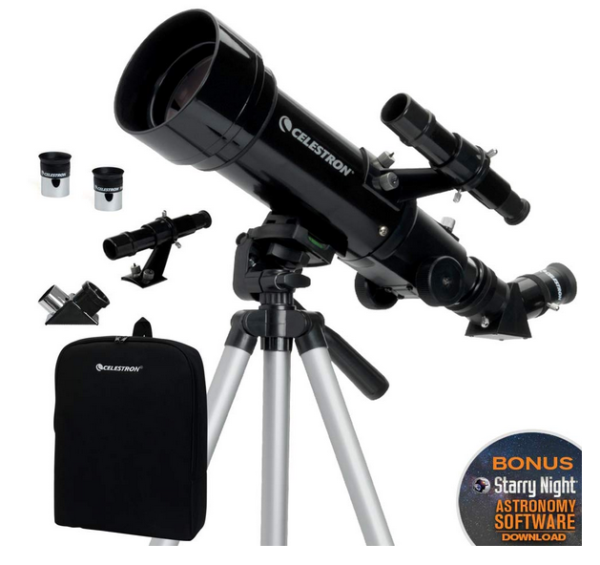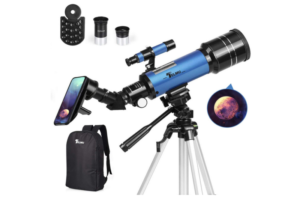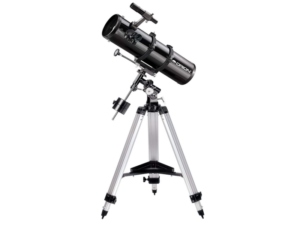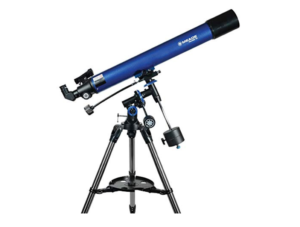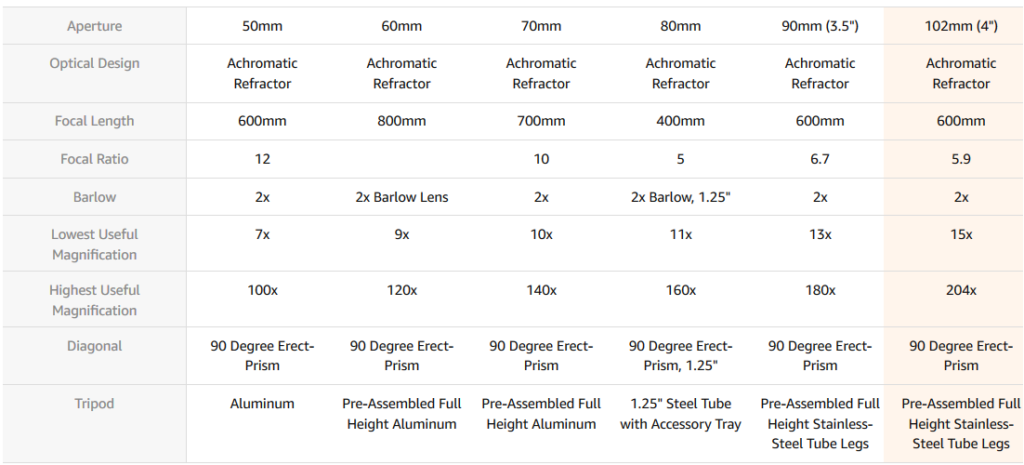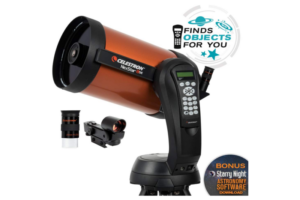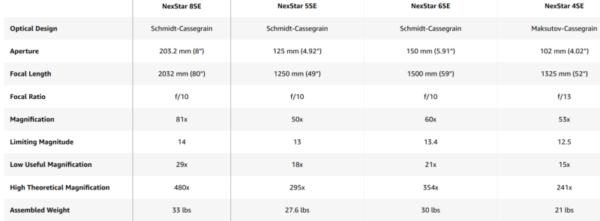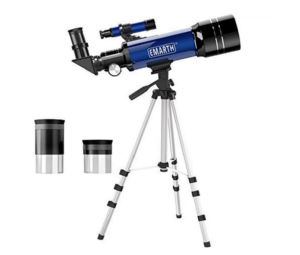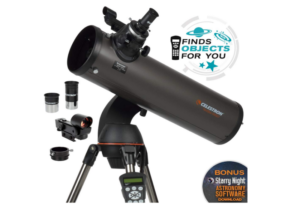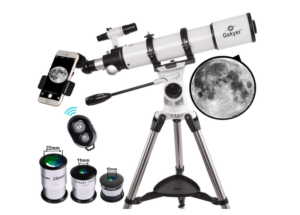Looking for the Best Telescopes for Beginners, Kids, Adults, Astrophotography, and more? Read on as we comprehensively cover the best on the market.
The world of telescopes and stargazing is a beautiful one. Stepping into it for the very first time can overwhelming especially in making the right telescope decision. The market is saturated with many telescopes, with different features, confusing accessories, and more which make the buying process complicated and hectic. The most important things to consider are pricing, quality, and performance.
This comprehensive review is your best Telescopes for Sale Guide. In this comprehensive guide, we will go through the Top Telescopes for sale and other categories such as the best for Beginners, Home Use, Kids, Adults, astrophotography, camping, and more.
Best Telescopes-Our Top Picks
Celestron – 70mm Travel TeleScope
See Best Price
The Celestron Travel Scope 70 is made for beginners, adults, kids, astronomy, home use, and more. It’s a professionally engineered refractor telescope that works best for celestial or terrestrial viewing. The Telescope has a fully-coated, high-quality glass optic and a refractor-style 70mm objective lens. The aperture on the telescope allows high-resolution viewing and doesn’t end extra weight. The added weight coating on the lens allows light to enter for sharper and crisper viewing during the day and night. Features
|
Gskyer AZ70400 70mm Telescope
See Best Price
The Gskyer AZ70400 70mm Telescope is one of the best telescopes for sale and can be used by beginner astronomers, experts, kids, adults, and other stargazers. The telescope is easy to assemble and use, top tier resolution and optical capabilities, it’s compact and portable. The Telescope has a lightweight body, accessories, and tripod and conveniently fits in the travel bag for easy movement. With this telescope, you get x120 magnification for clear images of the moon, stars, and planets. Features
|
TELMU 70mm Telescope
See Best Price
TELMU 70mm telescope for kids, Beginners, and adults is a compact universal telescope known for bright and great image quality. The telescope has high magnification power and is very effective in the exploration of the sky, moon, planets, star clusters, and fog. If you love nature this is the best telescope to view and enjoy endless landscapes, rivers, mountains, flowers and birds, and other animals. The Telescope has an Upgraded Tripod with 360 ° rotation and a full range of stable observations. You also get a 45 ° Diagonal Mirror for positive images both up and down. The Multiple Eyepiece gives a variety for any viewing. Specifications
What is in the Package
Features
|
Orion SpaceProbe 130ST Equatorial Reflector Telescope
See Best Price
The Orion SpaceProbe 130ST reflector telescope is perfect for beginners or intermediate stargazers, adults, kids, and Brighter deep sky viewing. With a 130-millimeter parabolic primary mirror, you are assured of great views. The EQ-2 mount with dual setting circles and slow-motion hand controls and a stable tripod ensures the telescope is sturdy and stable during use. In the Package
Specifications
Features
|
Meade Infinity Altazimuth Refractor Telescope
See Best Price
This Meade Infinity Altazimuth Refractor Telescope is available in 50mm, 60mm,70mm, 80mm,90mm, and 102mm apertures.
These telescopes are best for beginners, professionals, astronomical and terrestrial objects viewing, you get quality mounts and quality optics for a superb value. Features
|
Celestron NexStar Computerized Telescope
See Best Price
This Celestron NexStar Computerized Telescope is designed for the best stargazing experience for users of all levels, beginners, kids, adults, professionals, and more. It’s easy and fast to set up thanks to its SkyAlign procedure. The telescope is available as NexStar 4SE, NexStar 5SE, NexStar 6SE and NexStar 8SE, 8SE is the best.
Pros
Cons:
Features
|
Emarth 70mm Astronomical Refractor Telescope
The Emarth 70mm Refractor Telescope is a great telescope for observation of the moon, terrestrial objects, for kids or for beginners. It features all coated glass optical components for clean, crisp views. It’s compact and has a portable design for that traveler who is an on-the-go sky gazer. The Telescope has a smooth Functioning Altazimuth Mount which can be moved vertically. The Pan Handle is used to control the mount for easy pointing to objects Specification
In the Package
Features
|
Orion 90mm Equatorial Refractor Telescope
See Best Price
As one of the Best Telescopes, this Orion 90mm Equatorial Refractor Telescope comes with excellent optics and a great package of accessories. It’s easy to assemble and comes with 2 Sirius Plossl eyepieces, a 6×30 optical finder scope, and Orion’s Starry Night planetarium software. The telescope is used for deep-sky objects, the Moon, and planets. Pros:
Features
|
Celestron – NexStar 130SLT Computerized Telescope
See Best Price
This Celestron – NexStar 130SLT Computerized Telescope is made for beginner to intermediate users, adults, and kids in mind. This Star Locating Telescope has a database of over 4,000 stars and galaxies and is able to locate objects with accuracy. It’s compact and durable and has the Newtonian Reflector Optical Design. It’s easy and fast to set up and is compatible with all Celestron’s most popular accessories, In the Package
Pros:
Features
|
Gskyer AZ Astronomical Refractor Telescope
See Best Price
This Gskyer AZ Astronomical Refractor Telescope as one of the best telescopes on the market has an integral aluminum ally telescope optical tube and tube ring with mounting knob and safety screw. You also get optical coated components for clean and crisp views. High Power Eyepieces and Power Telescope The telescope has an Optical Tube Design with a Tripod made of stainless steel. Specifications
Features
|
Types of Telescopes
- Refracting telescopes -most telescopes on the market are Refracting telescopes. These types of telescopes use lenses instead of mirrors, the eyepiece is at the bottom, they are easy to use.
- Reflecting telescopes – these telescopes use mirrors and the eyepiece is at the top side of the main tube. These Reflector telescopes have larger apertures for crisp viewing of faint deep-sky objects.
- Catadioptric telescopes or Cassegrain Telescopes- These types of telescopes use both mirrors and lenses, the apertures are 3″ and larger. For these, the most common designs are the Schmidt-Cassegrain and Maksutov-Cassegrain. They are versatile and the best for lunar, planets, deep space, photography, and terrestrial viewing. They are also more expensive. Most are also Computerised
Choosing the Best Telescopes
Mounts– Mounts are very critical in determining how easy it’s going to be to follow a star while viewing. An Equatorial mount allows the user to follow the rotation of the sky or stars as the earth does. The Altazimuth mounts, on the other hand, have a simple design, they only move up, down, right, and left, if you want to follow the starts you have to move the scope.
Aperture– This is the diameter of the optical component.The bigger the aperture the more the light and the clearer is the view
Eyepieces– Eyepieces formats are 1.25″ and 2″, 1.25″ eyepieces are standard and in focal lengths and designs. 2″ eyepieces are best for low power wide fieldwork and only used with Telescopes that accept the size.
Finder-This is a telescopic accessory that aids in pointing the telescope at the object under observation in the sky. The best telescopes have finders.
Tripods– the best telescopes have adjustable, durable, and strong tripods
Portability– Lightweight telescopes are the best if you are a stargazer on the go
Magnification and Optical Capabilities – Magnification is very important, the higher the magnification the better the views. The lenses should be multi-layered and coated for increased brightness and clarity.
Installation and Assembly – The best telescopes are easy to assemble and install, it should not take you more than 20 minutes to assemble a telescope. Assembly is also enhanced by the available manuals
Price – Always go for a telescope that meets your budget and has great features, the above reviews are the best for you
Simplicity and Convenience – the best telescopes have lenses that are easy to swap, they are easy to fine-tune, set up, and more operations
Telescope Care and Maintenance
Things You should NEVER do
- Never look directly at the sun with a telescope unless you are using a solar filter. This can cause permanent eye damage
- Never use your telescope to project images of the sun onto any surface as it can cause damage to the telescope through Internal heat build-up
- Never use an eyepiece solar filter or a Herschel wedge to prevent direct sunlight through the eye.
- Never leave the telescope unsupervised
Care and Cleaning
- If dust builds up on the corrector plate, use a brush to remove the dust or a can of pressurized air. These are the best Cleaning Tips for your Telescope.
- If there is condensed moisture on the inside of the corrector, remove the accessories from the rear cell of the telescope
- Keep the telescope in a dust-free environment pointing down
- Internal adjustments and cleaning should be done by certified experts
Tips on Using Telescopes
- Plan with skymaps and any other gear needed for stargazing, photography, or any other activity you intend to do.
- Use the telescope with both eyes open for effectiveness and better views.
- Set up your telescope like 20 minutes before use to allow it to get used to the outside temperature
- If you are using the telescope at night allow your eyes to adapt to darkness
- Perfect your act of collimation for the telescopes manual for the best results
- Lower the Center of gravity for stability
- Keep your eyepieces under wraps when not in use
- Set up your telescope on a solid and level ground
- Snug up your fasteners by checking all bolts and nuts
- Take notes of your observations
- If the telescope shows a blurry picture adjust the focus
- If you are observing an outdoor target from indoors make sure to open the window
- Please read the instructions on the installation and use of any telescope
Related: Best Binocular and Telescope Reviews
Telescope Observation Tips
Observing the Moon-the best time to observe is during the partial phases period which is between the first and third quarters. During this period the long shadows reveal great details on the lunar surface. For increased contrast use filters
Observing Planets– for the best planets observation experience, make sure that the atmospheric conditions are at the best conditions. Don’t observe low on the horizon or when the telescope is directly over a source of radiating heat.
Observing the Deep Sky- for deep-sky viewing you need low-to-moderate power
Telescopes Terms Glossary
- Absolute magnitude- is the apparent magnitude that a star has when observed from a standard distance of 10 parsecs or 32.6 light-years.
- Alt-Azimuth Mounting- this is telescope mounting that uses two independent rotation axis for movement of the instrument in Altitude and Azimuth.
- Aperture – is the diameter of a telescope’s lens or mirror
- Azimuth – is the angular distance of an object eastwards along the horizon
- Binary Stars Binary – pairs of stars that orbit around a common Center of Mass because of their mutual gravitational attraction
- Collimation -aligning a telescope’s optics
- Equatorial mount – A telescope mounting where the telescope is set upon an axis parallel to the axis of the Earth, here the angle of the axis is equal to the observer’s latitude.
- Focal length -is the distance between a lens (or mirror) and the point at which the image of an object at infinity is brought to focus.
- Parallax- the difference in the position of the object against a background when observed from two different locations.
- Parfocal is a group of eyepieces that use the same distance from the focal plane of the telescope to be in focus
- Reflector -A telescope that uses mirrors
- Resolution – the minimum detectable angle detectable by an optical system
- Universe -All astronomical things, events, relations, and energies
- Variable Star -A star with varying brightness over time
- Zodiac -part of the Celestial Sphere that lies within 8 degrees on either side of the Ecliptic.
Conclusion
This is the best telescopes on the market guide for all telescope categories from kids, adults, stargazing, planets, galaxy, and more.
Related
![The Best Telescopes for Sale [Beginners,Kids,Adults,astrophotography]](https://outdoormoran.com/wp-content/uploads/2020/02/1-96.png)
